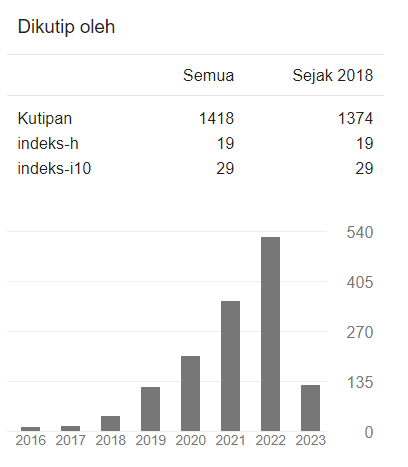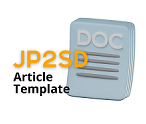Implementasi Pembelajaran STEM Low Cost di Sekolah Dasar untuk Mengembangkan Keterampilan Abad 21
DOI:
https://doi.org/10.22219/jp2sd.v11i2.25795Keywords:
STEM Low Cost, 21st Century Skills, Elementary SchoolsAbstract
Students in the 21st-century era must have many skills. There needs to be learning that supports an independent curriculum and project-based learning. Meanwhile, schools still carry out their learning activities using the lecture method, which is less meaningful and has yet to explore students' abilities fully. STEM is a skill and knowledge acquired simultaneously by students. The aims of this study are that researchers want to obtain deeper information about 1) the background of STEM-based learning at SDI Aisyiyah, 2) the implementation of STEM-based learning at SDI Aisyiyah, and 3) the skills students acquire during STEM-based learning at SDI Aisyiyah. Researchers want to obtain more in-depth information about the background of learning in the school, the application of STEM learning in the school, and the skills that can be formed from STEM-based learning. This research uses a qualitative method whose data processing uses NVivo12. Nvivo 12 is the latest version of the application for processing qualitative research data. The research findings support 21st-century learning, project learning during a pandemic, implementing an independent curriculum, providing STEM training, creating fun learning and creating a low-cost STEM culture. STEM learning is held once a week. The syntax in STEM learning at SDI Aisyiyah is as follows: 1. The teacher selects and breaks down KD/TP in learning, 2. Giving triggering questions or problems, 3. Finding solutions or problem-solving by teachers and students, 4. Product design, 5. Product presentation or presentation, 6. Product correction and evaluation, and the last is product revision. Some of the skills that can be formed from STEM learning at SDI Aisyiyah are being able to work together, being able to think complexly, having an artistic spirit, being a more communicative, more creative child, being independent, etc.
Downloads
References
Abe, E. N., & Chikoko, V. (2020). Exploring the factors that influence the career decision of STEM students at a university in South Africa. International Journal of STEM Education, 7(1). https://doi.org/10.1186/s40594-020-00256-x
Artobatama, I., Hamdu, G., & Giyartini, R. (2020). Analisis Desain Pembelajaran STEM berdasarkan Kemampuan 4C di SD. Indonesian Journal of Primary Education, 4(1), 76–86. https://doi.org/10.17509/ijpe.v4i1.24530
Arya Wulandari, I. G. A. P., Sa’Dijah, C., As’Ari, A. R., & Rahardjo, S. (2018). Modified Guided Discovery Model : A conceptual Framework for Designing Learning Model Using Guided Discovery to Promote Student’s Analytical Thinking Skills. Journal of Physics: Conference Series, 1028(1). https://doi.org/10.1088/1742-6596/1028/1/012153
Chomphuphra, P., Chaipidech, P., & Yuenyong, C. (2019). Trends and Research Issues of STEM Education: A Review of Academic Publications from 2007 to 2017. Journal of Physics: Conference Series, 1340(1). https://doi.org/10.1088/1742-6596/1340/1/012069
Dazhi, & Baldwin, S. J. (2020). Using Technology to Support Student Learning in an Integrated STEM Learning Environment. International Journal of Technology in Education and Science, 4(1), 1–11. https://doi.org/10.46328/ijtes.v4i1.22
Emily R. Miller & James S. Fairweather. (2012). The Role of Cultural Change in Large-Scale STEM Reform: The Experience of the AAU Undergraduate STEM Education Initiative. Landscape, 14(3), 53–61.
Estriyanto, Y. (2020). Menanamkan Konsep Pembelajaran Berbasis Steam (Science, Techology, Engineering, Art, and Mathemathics) Pada Guru-Guru Sekolah Dasar Di Pacitan. Jurnal Ilmiah Pendidikan Teknik Dan Kejuruan, 13(2), 68–74. https://doi.org/10.20961/jiptek.v13i2.45124
Hannover. (2020). Successful K-12 STEM Education: Identifying Effective Approaches in Science, Technology, Engineering, and Mathematics. National Academies Press.
Hinojo Lucena, F. J., Dúo-Terrón, P., Navas-Parejo, M. R., Rodríguez-Jiménez, C., & Moreno-Guerrero, A. J. (2020). Scientific performance and mapping of the term STEM in education on the web of science. Sustainability (Switzerland), 12(6), 1–20. https://doi.org/10.3390/su12062279
Indraswati, D., Marhayani, D. A., Sutisna, D., Widodo, A., & Maulyda, M. A. (2020). Critical Thinking Dan Problem Solving Dalam Pembelajaran Ips Untuk Menjawab Tantangan Abad 21. Sosial Horizon: Jurnal Pendidikan Sosial, 7(1), 12. https://doi.org/10.31571/sosial.v7i1.1540
Kefalis, C., & Drigas, A. (2019). Web based and online applications in STEM education. International Journal of Engineering Pedagogy, 9(4), 76–85. https://doi.org/10.3991/ijep.v9i4.10691
Li, Y., Xiao, Y., Wang, K., Zhang, N., Pang, Y., Wang, R., Qi, C., Yuan, Z., Xu, J., Nite, S. B., & Star, J. R. (2022). A systematic review of high impact empirical studies in STEM education. International Journal of STEM Education, 9(1), 1–18. https://doi.org/10.1186/s40594-022-00389-1
Marta Kowalczuk-Walêdziak, Alicja Korzeniecka-Bondar, W., & Lauwers, D. and G. (2015). A Time for Reflection and Dialogue: How Do We Educate Teachers to Meet the Challenges of the 21st Century? JSTOR, 3(April), 49–58.
Mu’minah, I. H., & Suryaningsih, Y.-. (2020). Implementasi Steam (Science, Technology, Engineering, Art and Mathematics) Dalam Pembelajaran Abad 21. BIO EDUCATIO : (The Journal of Science and Biology Education), 5(1), 65–73. https://doi.org/10.31949/be.v5i1.2105
Murphy, S., MacDonald, A., Danaia, L., & Wang, C. (2019). An analysis of Australian STEM education strategies. Policy Futures in Education, 17(2), 122–139. https://doi.org/10.1177/1478210318774190
Oketch, M. (2021). Addressing the learning crisis: basic skills and 21st century skills. In Education in the Asia-Pacific Region (Vol. 58). Springer Singapore. https://doi.org/10.1007/978-981-16-0983-1_3
Pfeiffer, H.D, Ignatov, D.I. dan Poelmans, J. (2021). Conceptual Structures for STEM Research and Education. 20th International Conference on Conceptual Structures, ICCS 2013 Mumbai, India, January 10-12, 2013 Proceedings.
Rahmawati, I., & Salehudin, M. (2022). Pengaruh Penggunaan Model Pembelajaran Abad 21 Terhadap Kemampuan Kognitif Peserta Didik Sekolah Dasar. EDUSAINTEK: Jurnal Pendidikan, Sains Dan Teknologi, 9(2), 404–418. https://doi.org/10.47668/edusaintek.v9i2.461
Reeve, J. (2012). A Self-determination Theory Perspective on Student Engagement. Depatment of Education, Korea University.
Reinholz, D. L., White, I., & Andrews, T. (2021). Change theory in STEM higher education: a systematic review. International Journal of STEM Education, 8(1). https://doi.org/10.1186/s40594-021-00291-2
Roberts, A. (2012). A justification for STEM education. Technology and Engineering Teacher, 74(8), 1–5.
Roberts, T., Jackson, C., Mohr-Schroeder, M. J., Bush, S. B., Maiorca, C., Cavalcanti, M., Craig Schroeder, D., Delaney, A., Putnam, L., & Cremeans, C. (2018). Students’ perceptions of STEM learning after participating in a summer informal learning experience. International Journal of STEM Education, 5(1). https://doi.org/10.1186/s40594-018-0133-4
Rubrics, C., & Resources, A. (2014). 4Cs RUBRICS. Additional Resources.
Rusydiyah, E. F., Indrawati, D., Jazil, S., Susilawati, & Gusniwati. (2021). Stem learning environment: Perceptions and implementation skills in prospective science teachers. Jurnal Pendidikan IPA Indonesia, 10(1), 138–148. https://doi.org/10.15294/jpii.v10i1.28303
Sa`dijah, C., Handayani, U. F., Cahyowati, E. T. D., & Sa’diyah, M. 2019. The Profile of Junior High School Students’ Mathematical Creative Thinking Skills in Solving Problem through Contextual Teaching. In Journal of Physics: Conference Series (Vol. 1397, No. 1, p. 012081). IOP Publishing.
Sihpiwelas, H., Sugiyono, & K. (2014). Peningkatan Keterlibatan siswa (student engagement) Secara Aktif dalam Pembelajaran IPA Menggunakan Pendekatan Kontekstual Pada Siswa Kelas IV. Pontianak: Jurnal Pendidikan Dan Pembelajaran, 3(3), 7–8.
Suebsing, S., & Nuangchalerm, P. (2021). Understanding and satisfaction towards stem education of primary school teachers through professional development program. Jurnal Pendidikan IPA Indonesia, 10(2), 171–177. https://doi.org/10.15294/jpii.v10i2.25369
Supena, I., Darmuki, A., & Hariyadi, A. (2021). The influence of 4C (constructive, critical, creativity, collaborative) learning model on students’ learning outcomes. International Journal of Instruction, 14(3), 873–892. https://doi.org/10.29333/iji.2021.14351a
Susan Elrod & Adrianna Kezar. (2012). Increasing Student Success in STEM: An Overview for a New Guide to Systemic Institutional Change. Landscape, 14(3), 53–61.
Syamsul Arifin, Punadji Setyosari , Cholis Sa’dijah, D. K. (2020). The effect of problem based learning by cognitive style on critical thinking skills and student retention | Arifin | Journal of Technology and Science Education. Jotse, 2020 – 10, 10(2), 271–281. http://www.jotse.org/index.php/jotse/article/view/790/477
Thahir, A., Anwar, C., Saregar, A., Choiriah, L., Susanti, F., & Pricilia, A. (2020). The Effectiveness of STEM Learning: Scientific Attitudes and Students’ Conceptual Understanding. Journal of Physics: Conference Series, 1467(1). https://doi.org/10.1088/1742-6596/1467/1/012008
Tiar Falentina, C., Abdul Muiz Lidinillah, D., & Hendri Mulyana, E. (2018). Mobil Bertenaga Angin Berbasis STEM. Pedadidaktika: Jurnal Ilmiah, 5(3), 152–162. http://ejournal.upi.edu/index.php/pedadidaktika/index
Timms, M. J., Moyle, K., Weldon, P. R., Mitchell, P., & Australian Council for Educational Research (ACER). (2018). Challenges in STEM learning in Australian schools : literature and policy review. In Australian Council for Educational Research. https://research.acer.edu.au/cgi/viewcontent.cgi?article=1028&context=policy_analysis_misc
Voogt, J., Roblin, N. P., Voogt, J., & Roblin, N. P. (2020). 21st Century Skiils. 21st Century Skiils, 1–54.
Wahono, B., Lin, P. L., & Chang, C. Y. (2020). Evidence of STEM enactment effectiveness in Asian student learning outcomes. International Journal of STEM Education, 7(1), 1–18. https://doi.org/10.1186/s40594-020-00236-1
Wismath, S., Orr, D., & MacKay, B. (2019). Threshold Concepts in the Development of Problem-solving Skills. Teaching and Learning Inquiry, 3(1), 63–73. https://doi.org/10.20343/teachlearninqu.3.1.63
Zubaidah, S. (2018). Mengenal 4C: Learning and Innovation Skills Untuk Menghadapi Era Revolusi Industri 4.0. 2nd Science Education National Conference, September, 1–7.
Downloads
Published
Issue
Section
License
Copyright (c) 2023 Shifni Afida Kumala, Cholis Sa'dijah, Syamsul Hadi

This work is licensed under a Creative Commons Attribution-ShareAlike 4.0 International License.
Authors who publish with Jurnal Pemikiran dan Pengembangan Sekolah Dasar (JP2SD) agree to the following terms:
- For all articles published in Jurnal Pemikiran dan Pengembangan Sekolah Dasar (JP2SD), copyright is retained by the authors. Authors give permission to the publisher to announce the work with conditions. When the manuscript is accepted for publication, the authors agree to automatic transfer of the publishing right to the publisher.
- Authors retain copyright and grant the journal right of first publication with the work simultaneously licensed under a Creative Commons Attribution-ShareAlike 4.0 International License that allows others to share the work with an acknowledgment of the work's authorship and initial publication in this journal.
- Authors are able to enter into separate, additional contractual arrangements for the non-exclusive distribution of the journal's published version of the work (e.g., post it to an institutional repository or publish it in a book), with an acknowledgment of its initial publication in this journal.
- Authors are permitted and encouraged to post their work online (e.g., in institutional repositories or on their website) prior to and during the submission process, as it can lead to productive exchanges, as well as earlier and greater citation of published work (See The Effect of Open Access).

This work is licensed under a Creative Commons Attribution-ShareAlike 4.0 International License.


















